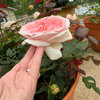The other thread has enough mistakes and false starts to get Thomas Aquinas all confused, so let's start over.
--There is ample scientific evidence that getting extra calcium into rosebuds reduces botrytis flower blight in cut roses by 2/3 to 4/5 and increases vase life by 1/3. Only greenhouse hybrid teas were studied, but the findings should have some pertinence for gardeners.
--Botrytis causes balling and rotting of flowers, red-spotting and brown rotten spots on petals. It also causes black cankers and dieback of green canes and gray mold on cuttings. One study found that extra calcium as a spray reduced botrytis stem lesions on tomato. Calcium has also been shown to control several other fungal diseases, especially on fruit.
--Calcium strengthens resistance to fungal attack by strengthening cell walls. It slows the aging of flowers and reduces production of ethylene gas. In one study, the high pH of calcium sprays was thought to reduce germination of botrytis as well.
--In various studies, extra calcium (beyond normal nutrition) was successfully applied in three different ways: through vase water solutions, by spraying buds before harvest, and by feeding through the roots. However, in fertigation experiments, little extra calcium reached the flowers when normal levels of potassium and magnesium were in the nutrient solution. This finding suggests that applying calcium to the garden soil wouldn't accomplish the full benefit.
--Calcium is not very mobile in plants and would not be translocated much if any from leaves (which would be a "downward" movement from leaf to stem), so buds and their stems need to be treated directly or from the roots.
--Various calcium salts were effective in the experiments, including calcium sulfate, calcium nitrate, and calcium chloride.
--Calcium sulfate--
I have been experimenting with garden gypsum, which is impure calcium sulfate dihydrate. It is slow to dissolve and will not form a strong solution. However, there is a convenient way to get a solution. Put 1 tb. gypsum in 1 gallon of water (for example, a clean water jug) and let stand for a week at room temperature. This should produce a solution suitable for spraying (10 mM to 25 mM). Pour off the solution, leaving the sediment. It's a good idea to measure the sediment at least once to see how much is dissolving, which will vary according to the purity of the gypsum and the fineness of particles. I recovered 1 tsp of sediment after a week, so 2/3 of the gypsum dissolved. If you get more than 1 tsp sediment, start with 4 tsp/gal next time so that at least 2 tsp dissolve in a week. The pH of my solution, without the spreader, is neutral.
I have sprayed this solution three times on some stems with no mechanical problems or damage to petals or leaves. Once I combined it with sulfur fungicide. A surfactant (spreader) is needed. I used one tsp/gal of insecticidal soap or dish soap. The scientific studies used a non-ionic surfactant, Tween 20 (polysorbate 20).
One could spray the whole garden or just spritz buds and flowers with their stems, especially those intended for cutting or exhibition.
For vase solution, dilute the spray solution with 3 parts water.
We haven't had much botrytis weather since I took this up. I have been comparing recently-sprayed with unsprayed-for-17-days buds of the same susceptible varieties. I wet them one evening before a cool night, 5 days ago. Although there is no severe botrytis on the control group, most flowers have minor symptoms. The recently-sprayed flowers are almost entirely clean. These stems were sprayed 3 times so far at weekly intervals, but there is probably little benefit from the older sprayings. Sprayed flowers seem to last longer as cut flowers.
--Calcium chloride--
This is available as ice melting and dust control products. Agricultural grade calcium chloride would also be sold in farm stores in areas where apples and other fruits are grown. Calcium chloride has more calcium than the other forms. Although it is more phytotoxic, it is commonly used in agriculture because it dissolves easily.
I haven't tried spraying calcium chloride, but I have used an impure form sold as ice melter in vase solutions. It seems to extend vase life.
Vase solution: 1/8 teaspoon/quart. Do not combine with bleach.
Spray: I would try 1 or 1-1/2 tsp/gallon, with a spreader. Solutions of 3-4 tsp/gal are used on apples, but are said to be phytotoxic to apple foliage above 81 F. Calcium chloride is said to be compatible with fungicides normally used on apple.
--Calcium nitrate--
Commonly available as fertilizer, it dissolves readily with a small amount of sediment. A fully soluble or greenhouse grade is also produced, and this could be used if there are any mechanical problems with the fertilizer. I have not experimented with it.
Vase solution: probably 1/4 tsp/quart.
Spray solution: probably 2 tsp/gallon, with spreader, dissolved separately before adding to the tank without the sediment.
















ceterum
duchesse_nalabama
Related Professionals
Belmont Landscape Architects & Landscape Designers · Finneytown Landscape Architects & Landscape Designers · Wilmington Landscape Contractors · Bristol Landscape Contractors · Hilton Head Island Landscape Contractors · Kaysville Landscape Contractors · Lantana Landscape Contractors · Melrose Park Landscape Contractors · Milford Landscape Contractors · Palos Verdes Estates Landscape Contractors · Parkland Landscape Contractors · Riverhead Landscape Contractors · Soddy Daisy Landscape Contractors · Westford Landscape Contractors · Northlake Landscape Contractorsceterum
erasmus_gw
michaelgOriginal Author
ceterum
michaelgOriginal Author
patriciae_gw
michaelgOriginal Author
ceterum
michaelgOriginal Author
ceterum
rose_nutty
michaelgOriginal Author
susan9santabarbara
pkapeckopickldpepprz
pkapeckopickldpepprz
monarda_gw